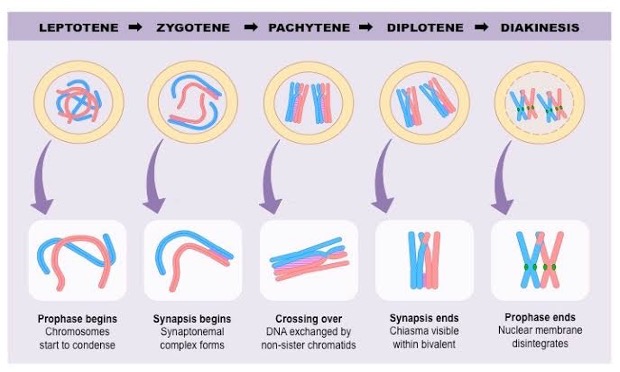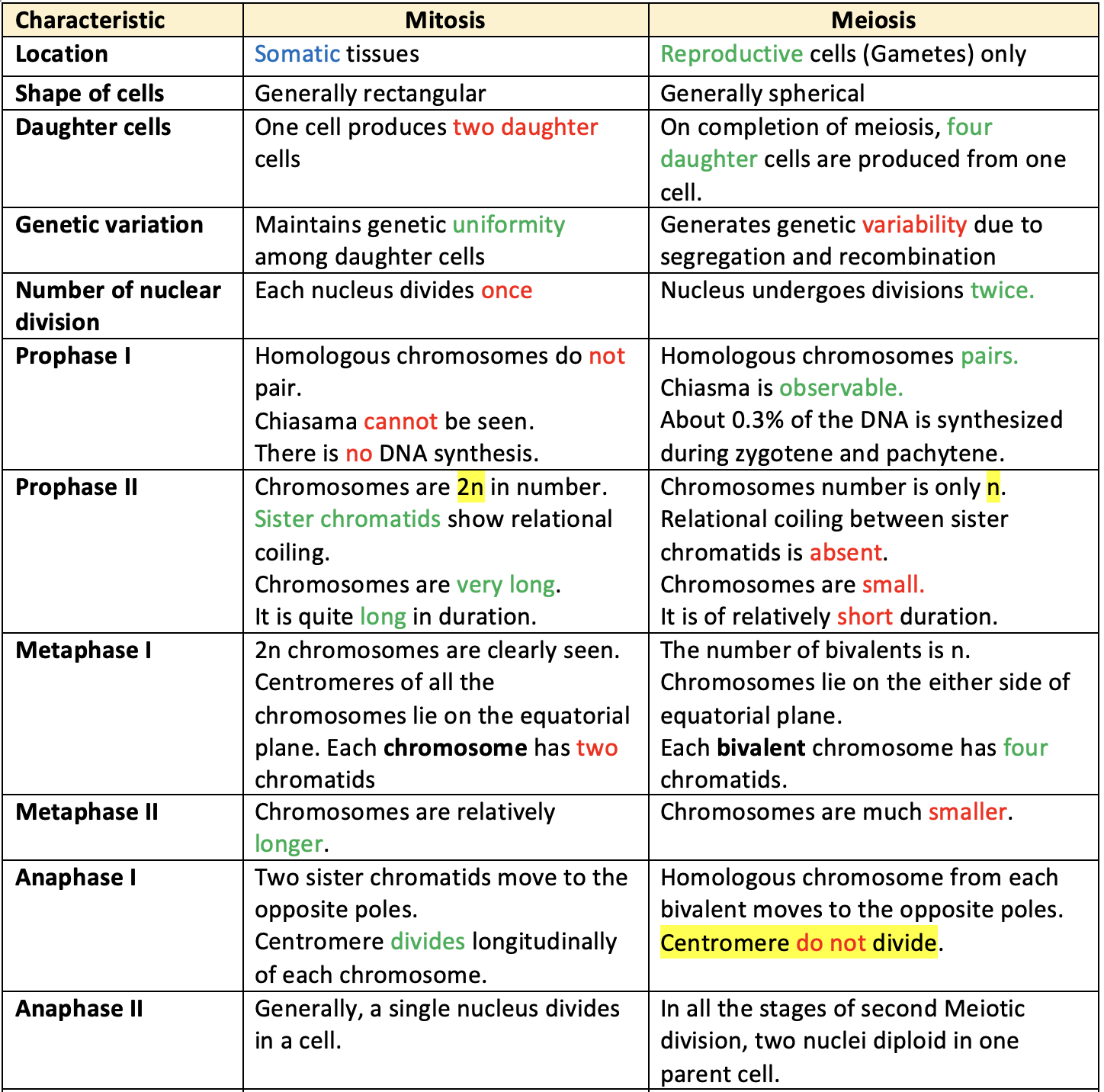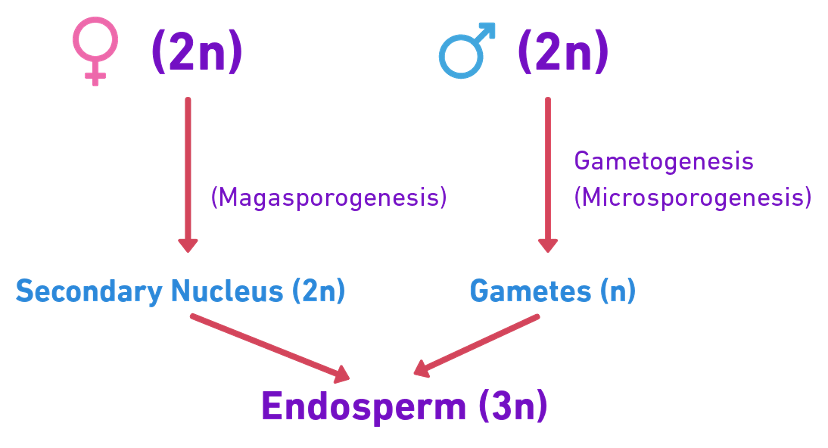⨵ Meiosis
Learn about Meiosis.
Meiosis
- Meiosis has two successive divisions (viz. meiosis I and meiosis II) with a short interphase in between them.
- Before undergoing meiosis I during the interphase genetic materials are duplicated due to active DNA replication.
- Karyokinesis I (Meiosis I):
Reductional division. It produces two haploid cells from a single diploid cell. - Interphase (Interkinesis):
No Duplication of DNA, short period. - Karyokinesis II (Meiosis II):
Equational division/simple mitosis.
- Karyokinesis I (Meiosis I):
Meiosis I/Karyokinesis I
- It has a long prophase, metaphase, anaphase and telophase.
Prophase I
- Prophase I is of longer duration than the mitotic prophase and most of the cytogenetically events such as synapsis, crossing over etc. take place during this prophase. It is the
longest stageand hasfivedistinct phases.
(a) Leptotene / Leptonema / Bouquet stage
- Name stands for Thin Thread / Thin Thread
- Each chromosome is longitudinally single with a large number of chromomeres. Chromomeres are the beads on the chromosome.
- Chromomeres are discovered by Balbiani.
- Chromosome appears as long thin (lepto) thread like structure hence the name leptotene or leptonema.
- In some cells chromosomes appear and look like a bouquet hence the name
Bouquet stage. - A definite type of orientation and polarization of chromosomes towards the centrioles takes place.
(b) Zygotene/Zygonema/stage of synapsis or syndesis
- Name stands for Coupled yoked
- Pairing of homologous chromosomes (i.e.
synapsis/syndesis) takes place calledsynaptonimal complex. - Each pair of homologous chromosomes is called
bivalent/Tetrad. Bivalent is formed as a result of synapsis. If pairing takes place from terminal region, it is called polarization. - Synaptonemal complex appears and controls pairing, Synaptonemal complex is in between two homologous chromosomes (one is maternal and other is paternal chromosome) and discovered by Mosses at zygotene.
- Nuclear Membrane and Nucleolus are present.
emoji="👀"
👉🏻 Homologues chromosomes means chromosomes with same size, shape and sequence of genes but alleles may differ.
👉🏻 Pairing at meiosis between two or more non-homologous chromosomes whether it be complete or partial from in an allopolyploid individual is called `allosyndesis`. RRB SO 2020
(c) Pachytene/Pachynema
- Name stands for Thick
- Longitudinal splitting of paired chromonemata along the length of chromonemata. The coiled filament of the chromosome which bears genes is called chromonema (chromonemata are plural) but there is no splitting of centromere.
- Splitting of chromonemata into chromatids takes place and bivalent has four chromatids.
- Chromatid + its own centromere = chromosome. As a result Tetrad stage (4 chromatids) of homologous chromosomes is found.
- Dehydration and condensation of chromosomes occurs.
- The exchange of chromosomal or genetic material between non-sister chromatids of each tetrad takes place. Such exchange of genetic materials between non-sister chromatids is called
crossing overwhich is the cause of hereditary variations. - Crossing over leads to recombination of genes.
- Stern and Hotta (1969) reported that endonuclease enzyme breaks the chromatid and ligase enzyme unites the broken non-sister chromatids.
- A small amount of DNA is synthesised to repair the broken chromatids.
- Percentage of crossing over helps in the preparation of genetic map or chromosome map. The unit of genetic map is centimorgan. 1 centimorgan means 1% crossing over. First genetic map was prepared by Sturtevant (of drosophila). Drosophila is the queen of genetics.
- Nuclear membrane and Nucleolus are present.
(d) Diplotene/Diplonema
- Name stands for Double
- Repulsion between homologous chromosomes begins.
- Terminalization of chiasma starts.
- Synaptonemal complex disappears.
- The point of crossing over (inter change) is called
chiasma(plural-chiasmata) which is visible as characteristic X-shaped configuration. - Nuclear membrane and Nucleolus present.
(e) Diakinesis
- It is the end of both diplotene and prophase I.
Terminalizationis the characteristic feature.- At the end, Nuclear membrane and nucleolus disappear.
- It is the best sub stage for counting the no. of bivalents.

Metaphase I
- Nuclear Membrane and Nucleolus are absent.
- Bivalents are at equator. Chromosomes are exactly in equatorial plane but not necessarily centromere.
- Chiasmata are completely terminalized means absent.
- Spindle fiber is connected with centromere only at one side.
Anaphase I
- Centromere does
not dividemeansno separationof centromere;no splittingof centromere. - Spindle fiber is connected with centromere at one side only.
- V-shaped chromosomes move to their poles.
Reduction in number of chromosomesi.e. n of 2n.- Nuclear membrane and nucleolus are absent.
- A tetrad is separated into diad and each diad has only one pair of chromatids.
- Here is simply separation of chromosomes.
- Every nucleus is in n-phase (half no. of chromosomes)
Telophase I
- Chromosomes reached to the respective pole.
- Formation of nuclear membrane and nucleolus after some period.
- 2 daughter nuclei are formed.
Interkinesis
- Nuclear membrane and nucleolus become prominent.
- No duplication of DNA.
Meiosis II (simple mitosis)
👉🏻 There is no prophase II. After certain period all the chromosomes lie on the equatorial plane immediately forming.
Metaphase II
- Centromere are exactly on the equatorial plane.
- Centromere are connected by spindle fibers on both sides.
- Nuclear membrane and nucleolus absent.
Anaphase II
- Longitudinal splitting of centromere.
Telophase II
- Nuclear membrane & nucleolus reappear.
- 👉🏻 Cytokinesis separates each nucleus from the others and thus the process of meiotic nuclear division completes.

Difference between Mitosis and Meiosis


Number of Cell Division Calculation
- Number of meiosis in pollen mother cell (PMC)
= n⁄4
-
Where, n = no. of pollens

-
No. of Meiosis in seed:
= n + n⁄4
- Where, n = no. of seeds
- For 100 ovules → 100 meiosis
- For 100 pollens → 25 meiosis
- 100 seeds → 125 meiosis
- No. of Mitosis:
= n - 1
- Where, n = no. of cells.
- Endosperm of angiosperm = 3n (n = no. of chromosomes)
- Endosperm of Gymnosperm = n
- Endosperm of angiosperm (3n)

Meiosis
- Meiosis has two successive divisions (viz. meiosis I and meiosis II) with a short interphase in between them.
- Before undergoing meiosis I during the interphase genetic materials are duplicated due to active DNA replication.
- Karyokinesis I (Meiosis I):
Reductional division. It produces two haploid cells from a single diploid cell. - Interphase (Interkinesis):
No Duplication of DNA, short period. - Karyokinesis II (Meiosis II):
Equational division/simple mitosis.
- Karyokinesis I (Meiosis I):
Meiosis I/Karyokinesis I
- It has a long prophase, metaphase, anaphase and telophase.
Prophase I
- Prophase I is of longer duration than the mitotic prophase and most of the cytogenetically events such as synapsis, crossing over etc. take place during this prophase. It is the
longest stageand hasfivedistinct phases. …
Become Successful With AgriDots
Learn the essential skills for getting a seat in the Exam with
🦄 You are a pro member!
Only use this page if purchasing a gift or enterprise account
Plan
- Unlimited access to PRO courses
- Quizzes with hand-picked meme prizes
- Invite to private Discord chat
- Free Sticker emailed
Lifetime
- All PRO-tier benefits
- Single payment, lifetime access
- 4,200 bonus xp points
- Next Level
T-shirt shipped worldwide

Yo! You just found a 20% discount using 👉 EASTEREGG

High-quality fitted cotton shirt produced by Next Level Apparel